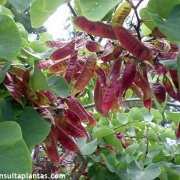Care of the tree Cercis siliquastrum or Judas tree |
|
The genus Cercis, family Fabaceae, comprises 10 species of deciduous trees native to the Eastern Mediterranean, the central and southern United States, and Asia. Some species are: Cercis siliquastrum, Cercis Canadis, Cercis sinensis, Cercis occidentalis, Cercis racemosa. Common names: Judas tree, Judas-tree. This species is native to Mediterranean region. They are trees with black and cracked bark (smooth and purple in young specimens) and a domed crown that reach 12 meters (39.37 feet) in height. The leaves are alternate, heart-shaped, circular or kidney-shaped, light green in spring and deep green in summer. The flowers are very decorative, small, and pink or white. It blooms in late winter or early spring; the flowers appear before the leaves. The fruits are purple-red hanging pods that turn brown and remain on the tree all winter. Judas tree is used in public parks and on streets, as isolated specimens on lawns or alongside other trees such as Magnolia grandiflora and conifers; potting is not recommended. Cercis siliquastrum needs full sun exposure (in semi-shade it produces fewer flowers) and protected from strong wind. It resists weak and occasional frosts. The ideal soil should be well drained and limestone and light. Plant in late winter. The transplant is done 3-4 years after sowing. it does not resist transplantation well when they are adults. Judas tree withstand drought well. Water each week with a bucket of water (spring and autumn) and with two buckets in summer. Fertilize with compost in the fall if grown in poor, arid soils. Cercis siliquastrum does not usually present serious pest and disease problems. Judas tree propagates from seeds sown in spring in a nursery. |
Images of the tree Cercis siliquastrum or Judas tree |
Find plants
Cercis siliquastrum or Judas tree | Care and Growing
© 2025 FavThemes




